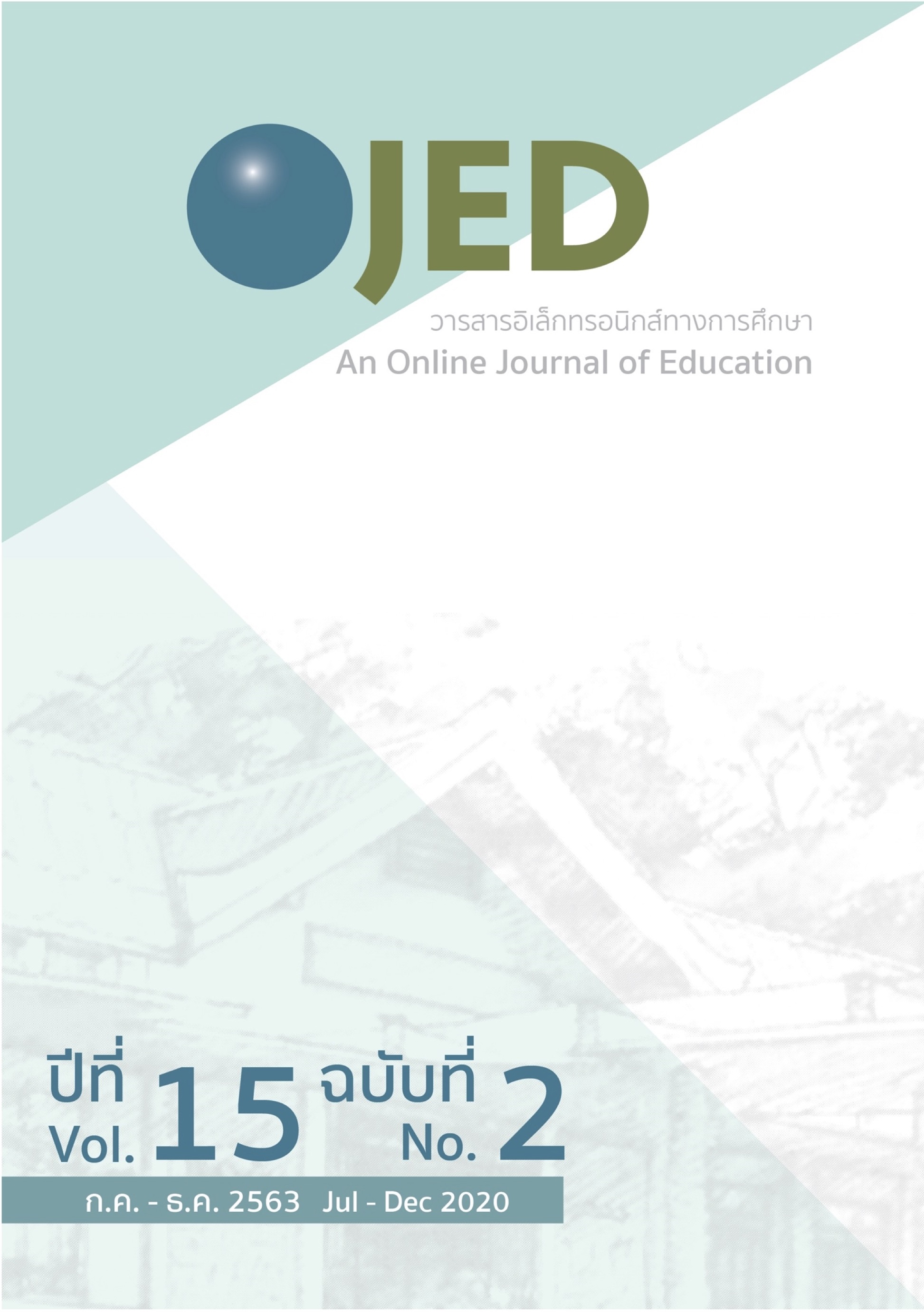Art Teaching Innovation to Enhance Peace Consciousness for Thai Youth: Case Study Pakkred Home Boys
DOI:
https://doi.org/10.14456/ojed.2020.10Keywords:
art, peace, art for peace, enhancing consciousnessAbstract
The objectives of this research were to 1) Develop art teaching innovation to enhance peace consciousness for Thai youth, 2) Study the effect on Thai youth peace consciousness before and after use of the art teaching innovation. The sample group was fifteen boys aged 16-17 year olds who were specifically selected from The Pakkred Home for Boys. The frequency and durations of the experiment comprised thirteen 50-minute sessions. The research instruments were 1) Art teaching innovation to enhance peace consciousness for Thai youth, 2) An observation form for individual behavior, 3) Peace consciousness evaluation (pre-test and post-test), and 4) Interview forms for 2 young children caregivers and 15 young children. Data was analyzed by using mean, standard deviation, and t-test dependent.
The research findings were as follows: 1) Art teaching innovation to enhance peace consciousness for Thai youth comprise art instructional guidelines to enhance peace consciousness consisting of a.Self-study and practice b.Group work c.Analytical and associative thinking d.Rational problem-solving e.Expressing personal opinions f.Open-minded listening g.Awareness of equality and respect for others.The researcher used art instructional guidelines to developed 10 art lesson plans that included peace learning topics. 2) The youth who were exposed to art teaching innovation to enhance peace consciousness for Thai youth had a level of peace consciousness (M = 3.77) higher than before learning (M = 3.29) at the significant difference level of .05. Moreoverthe youth were capable of self-study, group work, analytical and associative thinking, rational problem solving, expressing personal opinions, open-minded listening, and they had an awareness of equality and respect for others.
References
กรมพินิจและคุ้มครองเด็กและเยาวชน กระทรวงยุติธรรม. (2556). ประมวลสถิติด้านสังคมประจำปี 2556. http://www.m-society.go.th/ebook/uploads/doc/Socialbook4.
กระทรวงศึกษาธิการ. (2552). หลักสูตรแกนกลางการศึกษาขั้นพื้นฐาน พุทธศักราช 2551. โรงพิมพ์ชุมนุมสหกรณ์การเกษตรแห่งประเทศไทย.
คณะกรรมการการศึกษาแห่งชาติ. (2541). การศึกษากับการพัฒนาคุณธรรม. สำนักงาน คณะกรรมการการศึกษาขั้นพื้นฐาน.
ชลธิชา ขันติดิลกวงษา. (2540). ผลของการสอนศิลปะตามแนวคิดแบบเซอเรียลลิสต์ที่มีต่อผลสมฤทธิ์เรื่องสันติภาพของนักเรียนชั้นประถมศึกษาปีที่ 6 ในชุมชนแออัด กรุงเทพมหานคร [วิทยานิพนธ์ปริญญามหาบัณฑิต]. Chulalongkorn University Intellectual Repository (CUIR). http://cuir.car.chula.ac.th/handle/123456789/16604
ชูจิตต์ วัฒนารมณ์. (2529). คุณค่าของกิจกรรมศิลปศึกษาต่อนักเรียนระดับชั้นประถมศึกษาตมการรับรู้ของครู ศิลปศึกษาและผู้เชี่ยวชาญทางศิลปศึกษา กรุงเทพมหานคร [วิทยานิพนธ์ปริญญามหาบัณฑิต]. Chulalongkorn University Intellectual Repository (CUIR). http://cuir.car.chula.ac.th/handle/123456789/23352
พรรณี ชูจิรวงศ์. (2551). อานุภาพจิตใต้สำนึก. กรุงเทพมหานคร: สำนักพิมพ์ต้นไม้.
ไพบูลย์ วัฒนศิริธรรม และ สังคม สัญจร. (2543). สำนึกไทยที่พึงปรารถนา. โรงพิมพ์เดือนตุลา.
สุคนธ์ สินธพานนท์. (2551). นวัตกรรมการเรียนการสอนเพื่อพัฒนาคุณภาพของเยาวชน. 9119 เทคนิคพริ้นติ้ง.
Anderson, T. (2002). Mandala: Constructing Peace through art. Art Education, 55, 33-39.
Farthing, G. W. (1992). The psychology of consciousness. Prentice Hall, Inc.
Gold, D. (2006). The art of building peace: How the visual arts aid Peace-Building initiatives in Cyprus. Independent Study Project (ISP) Collection, Paper 370.
Song, Y. I. K. (2012). Educating for peace: A case study of a constructivist approach to understanding peace through artistic expression. Creative Education, 3, 79-83.
Kaneda, T and Abe, T. (2007). Art education for peace: Kids’ Guernica, International children’s peace mural project. InSEA Europe. http://www.insea.europe.ufg.ac.at/news/Kids%20Guernica.pdf
Poe, D. (2011). Communities of Peace. Rodopi.
Downloads
Published
How to Cite
Issue
Section
License

This work is licensed under a Creative Commons Attribution-NonCommercial-NoDerivatives 4.0 International License.




